Digging into 2012's archaeology
- Published
As much as science looked to the future this year in fields ranging from particle physics to planetary exploration, 2012 also gave us a rich view into the past. Here's a month-by-month view of what excited archaeologists through the year.
January

2012 started off with some archaeological reminders of the excesses of New Year. Following the news that Peruvians were snacking on popcorn as early as 4700 BC was evidence for early Maya tobacco use, external, with nicotine residues found in ceramic vessels from Mexico dating to between AD600 and AD900.
Next came the news that the notoriously beer-loving Vikings who settled in Greenland around 1,000 years ago were growing barley there, external - despite the cold climate - and thus were presumably able to brew their own.
February
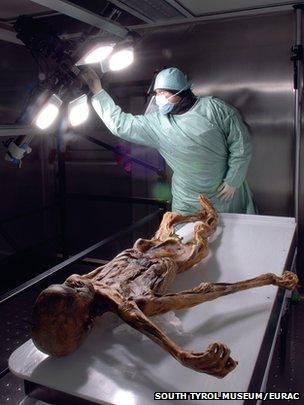
In February, the cold weather kicked in, accompanied by a chilly archaeology story about the whole-genome sequencing of "Oetzi the Iceman" - the mummified corpse of a man who was killed over 5,000 years ago in the Italian Alps.
Analysis of his DNA provided not only a unique window into Oetzi's personal life, but also a glimpse into ancient migration patterns in Europe. Previous analysis of his mitochondrial DNA, external had placed his maternal lineage a group from north-central Europe, while the new research found that his paternal ancestry belonged to a group found predominantly in Corsica and Sardinia.
His connection with modern Sardinians shows not that Oetzi was a Sardinian immigrant to the Alps - isotopic evidence from his teeth and bones prove that he grew up and lived close to where his body was found - but instead suggests a deeper shared ancestry between these Mediterranean islands and the Alpine region.
March
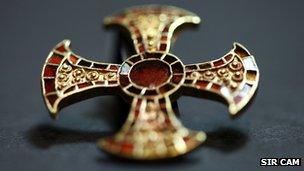
March brought the discovery of an unusual and elaborate burial from the 7th century AD that highlighted the dynamic changes in society that characterised late Anglo-Saxon England. Unearthed in a village just outside Cambridge was the grave of a teenage girl, buried on an ornamental bed and wearing a beautiful gold and garnet cross, external.
The burial merged pagan grave goods with Christian symbolism - a tangible manifestation of the transition from paganism to Christianity at a pivotal moment in the development of modern Britain.
April
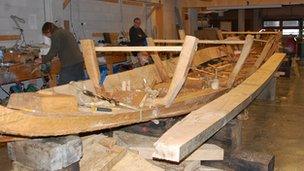
According to the Met Office, this April was the wettest in over a century. It was in this wet weather that archaeologists, engineers and boatbuilders joined forces to discover how people built boats in the Bronze Age, external.
Work began on a full-sized replica of a Bronze Age stitched boat at the National Maritime Museum Cornwall. Its design was based on a vessel discovered at North Ferriby on the Humber foreshore. Such boats were apparently used to trade metals such as tin, copper and gold with the European mainland.
May
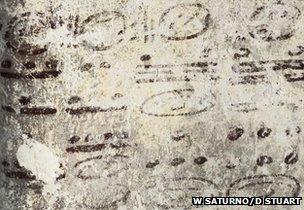
May brought news of the oldest Maya astronomical calendar discovered so far, from the 9th Century. The calendar was depicted in murals, external painted on the inner walls of an abandoned building at Xultún, possibly the workroom of a scribe.
Hieroglyphics written on some of the walls gave calendrical and astronomical tables for lunar and planetary cycles up to 7000 years into the future, debunking the theory that the Maya believed the world would end in 2012.
June
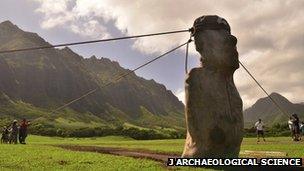
June saw the publication of a book challenging the theory that Easter Islanders destroyed their forested environment, external and wasted natural resources in the course of transporting almost 1,000 of the famous Moai statues into position.
Instead, the authors emphasise the success of the islanders' survival in such a marginal ecological environment. The widespread deforestation, they argue, was not due to human overexploitation of wood, but due to the arrival of rats along with the earliest settlers. These rats, with no natural predators, soon overran the island, eating the seeds of the trees and interrupting the natural cycle of forest regrowth.
Indeed, perhaps the statues were not transported using wooden rollers, external, as previously thought. Footage of a team of archaeologists, external walking the statues into position provides an alternative hypothesis to rolling them along on tree trunks, external. However, the jury is still out, external.
July

Lingerie from the Middle Ages was among almost 3,000 beautifully preserved fabric items that were found during reconstruction works at Lengberg Castle in Austria.
Among the extremely rare fabric pieces were a 15th-Century bra and knickers, external similar to those worn today, providing a glimpse into the very private matter of underwear in medieval Europe.
August

Two years after the disruption caused by Icelandic volcano Eyjafjallajökull came news of a somewhat more powerful and deadly volcano that erupted around 750 years ago. Ejecting eight times the volume of debris than the 1883 eruption of Krakatoa, external, this was the largest known eruption of the last millennium. The location of the volcano itself is still a matter of debate, external, but the effect it had around the globe remains visible in ice cores, lake sediments, and now mass graves excavated in London, external.
Historical documents record the devastation reaped by the eruption in AD1258 as the plume of aerosols ejected from the volcano shielded the earth from sunlight and warmth. Thousands of miles away in St Albans, a monk penned his observations of the deteriorating weather, unaware of its volcanic cause. Crops failed and thousands starved; as epidemiologist William Farr put it in 1846, external, "in London alone 15,000 of the poor perished".
During excavations at Spitalfields cemetery by Museum of London Archaeology (pictured), several burial pits were discovered. Although these graves bore similarities to the "plague pits" of the 14th Century, radiocarbon dating placed them in the mid-13th Century, thus potentially providing the first archaeological evidence, external for the 1258 volcano.
September
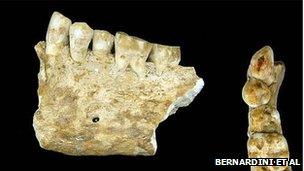
One of the earliest examples of prehistoric dentistry came to light this month with the chance discovery of a beeswax filling in a cracked Neolithic tooth, external. The tooth belonged to a 24- to 30-year-old man who lived approximately 6,500 years ago in what is now Slovenia.
High-resolution 3D imaging of the tooth revealed an area of exposed dentine as well as a vertical crack extending down to the pulp chamber. The beeswax seal may well have been an attempt to soothe his inevitable toothache.
October
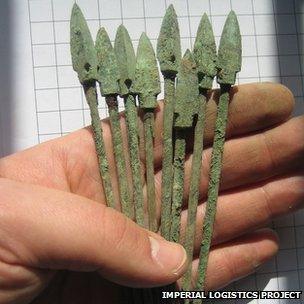
New research, external by University College London and the Museum of Emperor Qin Shi Huang's Mausoleum shed light on the sophisticated production model used to create the 7,000 warriors, chariots and horses of the Terracotta Army just over 2,000 years ago - following the exciting find in June of 100 more warriors.
Co-ordinating a workforce of over 700,000 men to create finely crafted items to a high level of standardisation was a massive organisational feat that demanded the most innovative of production systems. Analysis of the bronze arrowheads carried by the warriors led researchers to suggest, external that the Army was built using a production process now referred to as "Toyotism", named after the Japanese car firm.
Unlike an assembly-line model, where specialised production units make individual components, this process utilises cellular workshops with highly skilled and versatile craftspeople, external that make complete end products: a flexible production system that maximises labour and minimises waste.
November

Heading into winter saw a burst of new evidence to overturn the view that people in Mesolithic Britain were constantly on the move, living in temporary shelters that left little trace in the landscape.
Mesolithic structures were excavated at Echline in Scotland and Lunt Meadows in Merseyside, dating to 8300BC and 5800BC, respectively. The Scottish "house" was a timber and turf structure, occupied seasonally during the winter months. In Merseyside, three structures were found, external, leading archaeologists to suggest that several families lived in the area for at least part of the year.
New research at Star Carr, external, one of Britain's most famous Mesolithic sites (pictured), corroborates these findings. Around 11,000 years ago, Star Carr extended over 2 hectares, with a 30m-long wooden lakeside platform and at least one post-built house - not the signature of a small hunter-gatherer camp.
December
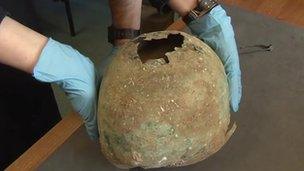
December saw the discovery of a very rare cremation burial, external in an equally rare Iron-Age helmet. The bronze helmet, dating to the 1st Century BC, once contained a bag of cremated bone held together with a brooch - the first example of a bag burial in a helmet. Continuing analysis of the helmet, brooch and bone will hopefully shed light on how this helmet - originally from outside Britain - made its way to a field near Canterbury at a time of war and Roman invasion.
Yet to come...
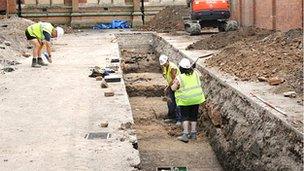
Early in 2013 we can expect to finally hear the DNA results on the human remains found in a car park in Leicester.
The results will be released at a press conference in January, though early reports suggest, external that the remains will be confirmed as those of King Richard III.